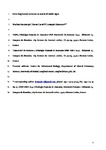Detecting horses’ sickness: In search of visible signs
| dc.contributor.author | Hausberger, M | |
| dc.contributor.author | ESTEBAN , ARRIBAS REYES | |
| dc.contributor.author | Lesimple, C | |
| dc.date.accessioned | 2017-12-12T18:02:17Z | |
| dc.date.available | 2017-12-12T18:02:17Z | |
| dc.date.issued | 2016-02 | |
| dc.identifier.issn | 0168-1591 | |
| dc.identifier.issn | 1872-9045 | |
| dc.identifier.uri | http://hdl.handle.net/10026.1/10414 | |
| dc.description.abstract |
Assessing sickness in animals, by which we refer to non-specific states involving both physical discomfort and negative emotional states, is a real challenge. In this review, we demonstrate the need for clear and simple indicators of sickness in horses, a species in which suffering is largely underestimated. We provide a critical review of existing tools available to assess sickness in equids, which include composite pain scales and scores and welfare assessment scoring. Many such scales and scoring systems involve subjective assessments and lack of clear definitions. We discuss possible objective, visible indicators (qualitative and quantitative behavioural modifications and some postures) associated with sickness in horses, highlighting the two predominant modalities of expression (becoming unresponsive to environmental stimuli and “lethargic”, or becoming aggressive and hostile). Much work is still needed before an agreement can be achieved on the indicators of sickness in horses; there are however signs that, even if non-specific, should attract the owners’ attention on the horses’ welfare states. | |
| dc.format.extent | 41-49 | |
| dc.language | en | |
| dc.language.iso | en | |
| dc.publisher | Elsevier BV | |
| dc.subject | Horses | |
| dc.subject | Illness | |
| dc.subject | Indicators | |
| dc.subject | Sickness assessment | |
| dc.subject | Welfare | |
| dc.subject | Pain | |
| dc.title | Detecting horses’ sickness: In search of visible signs | |
| dc.type | journal-article | |
| plymouth.author-url | https://www.webofscience.com/api/gateway?GWVersion=2&SrcApp=PARTNER_APP&SrcAuth=LinksAMR&KeyUT=WOS:000371654500007&DestLinkType=FullRecord&DestApp=ALL_WOS&UsrCustomerID=11bb513d99f797142bcfeffcc58ea008 | |
| plymouth.volume | 175 | |
| plymouth.publication-status | Published | |
| plymouth.journal | Applied Animal Behaviour Science | |
| dc.identifier.doi | 10.1016/j.applanim.2015.09.005 | |
| plymouth.organisational-group | /Plymouth | |
| plymouth.organisational-group | /Plymouth/Faculty of Science and Engineering | |
| plymouth.organisational-group | /Plymouth/REF 2021 Researchers by UoA | |
| plymouth.organisational-group | /Plymouth/REF 2021 Researchers by UoA/UoA04 Psychology, Psychiatry and Neuroscience | |
| dcterms.dateAccepted | 2015-09-04 | |
| dc.identifier.eissn | 1872-9045 | |
| dc.rights.embargoperiod | Not known | |
| rioxxterms.versionofrecord | 10.1016/j.applanim.2015.09.005 | |
| rioxxterms.licenseref.uri | http://www.rioxx.net/licenses/all-rights-reserved | |
| rioxxterms.type | Journal Article/Review |


